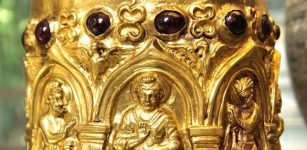Hidden Ancient Underground Tomb Discovered In Petra May Solve The Mystery Of The Nabataean Kingdom
Jan Bartek - AncientPages.com - A significant archaeological discovery has been made in the renowned lost city of Petra, Jordan. Researchers have uncovered a rare, ancient underground tomb that could provide new insights into the Nabatean Kingdom. This remarkable find was achieved by a team that includes academics from the University of St Andrews.
The Nabataeans were known for their prosperous kingdom, which had its capital at Petra, until the early second century. Archaeologists who have studied this area describe them as highly skilled people, and this discovery may help solve some longstanding mysteries about their civilization.
Now Professor Richard Bates, from the St Andrews School of Earth and Environmental Science, who was part of a collaboration carrying out research at Al-Khazneh, the Treasury Building, at the World Heritage Site of Petra, has announced that the team found a long-buried tomb with the remains of 12 ancient skeletons beneath the iconic building, which attracts more than a million visitors a year.
The recent unexpected discovery is now feautered in a new Discovery Channel documentary titled "Excavation Unknown." This two-part program, featuring adventurer Josh Gates and airing this month, unveils a historic excavation.
Credit: Pixabay - ChiemSeherin - Public Domain
At the heart of this exploration is the Treasury, located within an entire city intricately carved by hand into desert canyon walls by the Nabatean Kingdom 2,000 years ago. While it gained fame as the fictional resting place of the Holy Grail in "Indiana Jones and the Last Crusade," its true purpose remains elusive.
The research team obtained permission to perform a remote sensing scan followed by an excavation beneath the Treasury. These noninvasive techniques, electromagnetic conductivity, and ground-penetrating radar were employed to gather data. According to Professor Bates, "The main purpose of the survey was to assess the condition of the areas around the Treasury, its courtyard, the plaza, the exit of the Siq and the wadi into which they all feed, in advance of potential future works to divert and better control flood waters."
Through their survey efforts, they discovered probable underground chambers around the Treasury, which led to the development of a detailed excavation plan. This plan was executed by a collaborative team from ACOR and Jordan's Department of Antiquities. This revealed the presence of a tomb, with burials still in their ancient locations.
"The discovery is of international significance, as very few complete burials from the early Nabataeans have ever been recovered from Petra before. The burials, their goods, and the human remains can all be expected to help fill the gaps in our knowledge of how Petra came to be and who the Nabataeans were," Professor Bates said in a press release.
Dr. Tim Kinnaird, a specialist from the University of St Andrews School of Earth and Environmental Sciences, was tasked with sampling and dating the sediment around the burial sites as well as material from the tomb enclosure. His analysis yielded important chronological data, indicating that the construction of the tomb's walls occurred between the mid-first century BC and the early second century AD.
The tomb was most likely built as a mausoleum and crypt in the Nabatean Kingdom at the beginning of the first century AD for Aretas IV Philopatris. Like many tombs in the valley, few remains have ever been found in the tombs due to their subsequent use and reuse over the last two millennia.
"It's fantastic that we now have the pottery, ecofacts and sediments to date when the Treasury was constructed. Previously we've worked on assumptions and conjectures—to have a definitive date will be a monumental achievement for us all," Dr. Kinnaird said.
In the chamber, a skeleton was discovered holding a ceramic vessel. Upon detailed examination, this vessel has been identified as the upper portion of a broken jug, which likely dates back to the first century B.C.
Credit: St Andrews School of Earth and Environmental Science - Image compilation Ancient Pages
"It was an incredible privilege to be able to survey at such an iconic site and to have the geophysics verified with an excavation so soon is a rare opportunity. The extent of the discovery was so unexpected but will likely shed light on not only the Treasury building but also on the whole of the Nabatean society," Professor Bates said.
See also: More Archaeology News
"There is so much that we have yet to learn about the Treasury. When was this remarkable structure built, and why? Little did we know that this dig might completely change what we know about The Treasury and help solve the mysteries of the Nabataean people. With the support of the Jordanian government, this excavation is bringing us closer than ever to answers," Archaeologist Pearce Paul Creasman, Executive Director of ACOR, said.
Written by Jan Bartek - AncientPages.com Staff Writer























